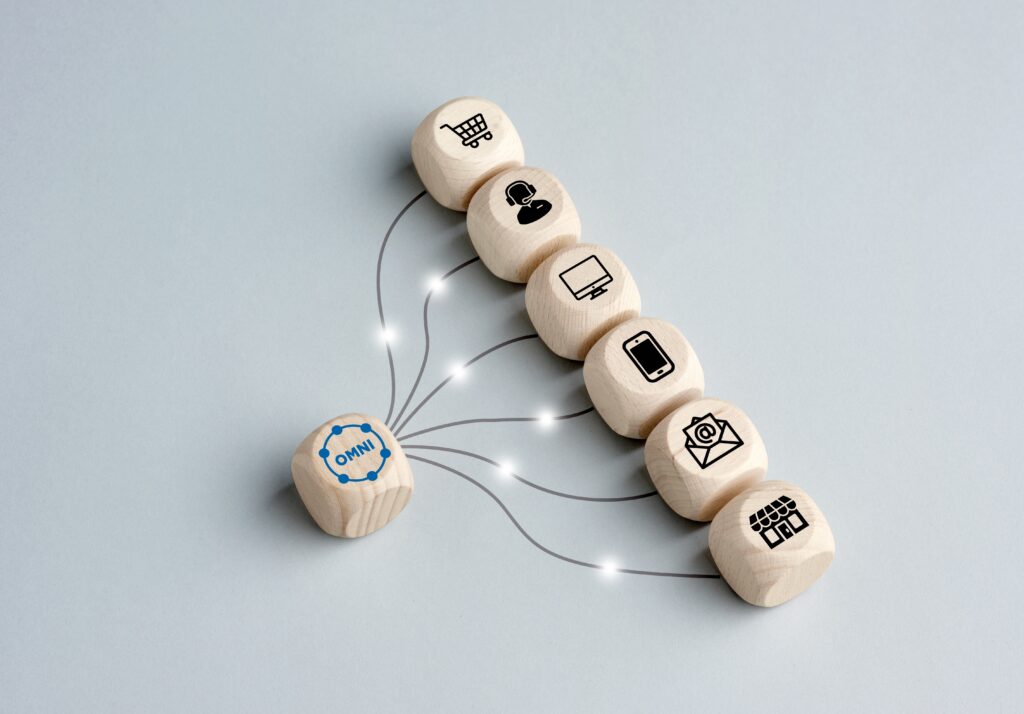The 4 steps to implement Digital Transformation in your business
The digital revolution changed the speed of all markets. For your company to truly seize the opportunities that digital technologies offer, it is necessary to invest in technology, creativity, and innovation.
This is the fastest way to start the digital transformation of your business.


But after all, what does it mean to be digital?
Being digital has meant a lot of things. But after 2010, the digital age became a reality. Conceptually, in 2011 the Digital Revolution begins due to the various technological advances that directly impacted our lives.
The term "digital" until then was used in 3 different ways, which are:
- Digitization
- Digitalization
- Digital transformation
What is Digitization?
Digitization is the conversion of analog or physical information into a digital format. For example, instruction manuals that were previously on paper, and now we have them in a digital format.
What is Digitalization?
Digitalization is the use of digital technologies to enable or improve business models and processes, being a clear process of exploring digital opportunities.
For example: Netflix's business model involves using digital opportunities by pioneering the streaming model, such as paid-access to their digital product offerings. This represents the digitalization that the company has performed.


What is the definition of digital transformation?
Digital transformation is defined as the coordinated efforts aimed at implementing the digitalization of businesses on a larger scale.
The main objective is to achieve significant results for the organization. Therefore, the expansion of organizational transformation reaches the operating model in all aspects of the business, including:
- Metrics
- Goals
- People
- Processes
- Technologies
An example of digital transformation in organizations is the integration of various digitization initiatives, such as:
- Use of augmented reality
- 3D printed tools
- Internet of Things (IoT) enabled sensors
- Blockchain for transaction storage
- Deep Learning applied to information systems
- Biometrics for security and identity management
Such connected resources can result in fundamental transformation of diverse business processes. It is possible to analyze that there was a logical and progressive sequence of the meaning of the term digital. Moving from digitization, digitalization to digital transformation.
It is important to understand the differences, analyze the stages the company is at and map the necessary progress towards the digital transformation of your enterprise.
Digital transformation starts in the entrepreneur's mindset. It is up to him to lead and be involved in implementing the digital transformation in his organization.


The Digital Revolution – The Fourth Industrial Revolution
According to Professor Klaus Schwab, the digital revolution is the Fourth Industrial Revolution, and it started in 2011.
This milestone was constituted due to the progression of digital technologies (digitization and digitalization) converging at a time when all of them became interconnected.
And, consequently, they are transforming the world and society in an integral way.
The speed of change
Fortune 500 is an annual list that lists the top 500 corporations in the United States by total revenue collected for the year. And to compare the speed of change in business, let's use it as a basis.
In the 1980s, it took a company about 20 years to reach a $ 1 billion valuation. However, companies born in the digital age, such as Uber, WhatsApp, Snapchat, each took less than 4 years to reach the same value.
Another comparison that can be made to definitively understand the impact of the digital revolution and the speed of change because of it: it’s the performance of companies in past decades with current market leaders.
Today the most valuable company in the world and a leader in retail is Amazon. It was founded in 1994 and first started as an e-commerce in books.
In the 1990s, Circuit City was one of the most valuable companies in the world and a leader in the retail industry. It grew rapidly and used its financial power to start other companies, including a technology company, a bank and CarMax. (America's largest used car retailer with a market value of $ 16 billion).
The company was recognized for its excellent service and products, considered at that time as revolutionary in the customer experience. But on January 16, 2009, its bankruptcy was announced.
It seems inexplicable how an extremely successful company declares bankruptcy a few years later, but Circuit City could not compete with Amazon, which had a business model without physical stores, a technology capable of offering useful suggestions on what the customer might be interested in and purchase. All designed to improve your sales performance and provide a pleasurable user experience.
In less than 20 years, the former leader in the retail sector, Circuit City has gone to complete ruin.
Comparing the above cases means that companies without a digital transformation mindset urgently need to think more like digital native companies.
The big mistake of older companies is to think that what worked until today will continue to bring the same results, being complacent in the face of this revolutionary change.


How to meet new consumer profiles
The 4 steps to implementing digital transformation
For your company to start implementing the digital transformation, you need to have four things:
Digital mindset
The first step is to have a digital mindset, as it is necessary to digitalize the culture of the entire organization.
Having a digital mindset is essential from the hiring process, as well as encouraging other employees to learn new technologies. This is because the speed of change is essential for the company to quickly adapt to new technologies and techniques that emerge.
Many technologies we are comfortable with today may be obsolete tomorrow. Therefore, it is important that everyone in the company has a digital mindset and disposition to train and learn the most modern technologies and techniques.
Pursuing modernity
The second step is knowing how to use and apply modern solutions. This is an internal component of the digital transformation and, typically, companies tend to be late thinking about it.
There are several modern technologies, such as:
- Cloud computing
- Big Data
- Technology for mobile devices (Apps)
- Analytical Management Platforms
Thus, as in the case of Circuit City, which did not invest in online sales and relationships, it is essential for all companies to invest in modern solutions so as not to fail in the competition for the market.
Innovate your business with digital channels. Innovate your company with high-performance digital solutions.
Technologic innovation
Step 3 aims to pursue new business opportunities by exploring innovative digital technologies. In many cases, innovation is beyond the limit of current offerings. Thus, it is necessary to develop or improve products or services with innovation based on cutting-edge technology. This should be part of long-term planning.
It is important that there is freedom for planning teams to explore new opportunities.
Digital experience for the customer
Step 4 is to improve the customer experience through digital channels.
We are living in the digital age, the digital customer age. That's why it's imperative to provide them with easier, more intuitive, and more engaging digital experiences.
You have to exceed customer expectations at every stage of your shopping journey. This is done by having a solid digital presence, through social networks and a corporate website, knowing your customers well and having analytical tools to assess each of the points of this journey. These are fundamental points for digital opportunities to transform the business reality.
See how we manage Social Media.
Understand more about how to apply Customer Success in your company
Discover the 6 steps to increase your digital authority!
Request your high-performance corporate website
The digital revolution is a fact! And it can be a huge threat to many companies, but it is arguably a unique opportunity for innovative entrepreneurs who take advantage of the new operating dynamics to grow even more.
Click here and see the companies that are innovating their corporate management with state-of-the-art technology.


The 4 levels of digital maturity
1. Digitally active companies
Companies that are at this stage are able to take advantage of digital transactional solutions to increase their revenue.
They have the 10 entry-level points listed above and know how to use these resources analytically, in addition to applying operational improvements, such as the introduction of agile development methods.
Organizations with this degree of maturity develop metrics or key performance indicators to measure business progress.
Due to the enormous ease of implementation, even family businesses are digitally active.
However, it is necessary to be aware and develop, as the trend is that companies that remain only at this stage will likely disappear rather than prosper.
2. Digitally engaged companies
The characteristic of companies that are in this phase is that they have already developed digital solutions and processes throughout the organization.
Due to the technological tools implemented in the company's culture, working digitally is widespread in all departments of the company, and even its operational model is digitally very well defined.
Compared to digitally active companies, digitally engaged organizations use automation of different processes, have more robust and advantageous analysis tools, which, consequently, give them a huge volume of critical information, capable of directing them to completely strategic decisions.
For reasons of opportunity and self-preservation, most retailers today should be at this stage. Only then will they be able to compete with companies considered digital natives.
3. Digitally competitive companies
Companies with this degree of maturity understand that digitized tools and processes can be used in an integrated and comprehensive way.
In the view of these businesses, digital transformation not only serves to generate more revenue but is also a key part of helping to foresee future needs – and thus develop strategies in an agile way to close the identified gaps.
Digitally competitive companies have a broad customer focus as they are able to seamlessly integrate:
- Operating model in digital format
- predictive analytics
- An architecture of microservices
This merge allows digitally competitive companies to have real-time data on customer wishes and feedback. Thus, they quickly transform this data into solutions, services or products that increase their revenues.
Companies with this digital level already use artificial intelligence in their business models – for example in business applications.
The use of machine learning (Internet of Things – IoT) is also part of it, even if in a rudimentary way, to improve Big Data analysis and provide better decision-making.
Understand this concept with an example
Walmart is an example of a company that needed to reinvent itself and is now considered a digitally competitive company. The big reason for this change was their competition, as they lost a lot of market after Amazon's rise in the retail sector.
To be able to compete with much more native digital, younger, and more agile companies, Walmart had to develop an e-commerce group and then acquire the e-commerce company, Jet.com, for more than $ 3 billion.
This boosted Walmart in its digital transformation process and, as a result, they currently have a new level in their ability to compete in the market.
4. Digitally mature companies
Companies that have achieved digital maturity often use artificial intelligence (AI) extensively in their businesses.
Strategic business planning is integrated with AI being a powerful valve for continued growth. And that makes these companies dominate their digital market.
Using exclusive digital channels, all implemented features provide a considerable increase in revenue generation, new products, and new digital services.
The main difference between these maturity levels is, in addition to having the tools, they know what to do and how to use all available information in an agile way. Digitally mature companies are able to transform customer data and organizational data into ongoing opportunities to grow new businesses.
Organizations at this level exceeded customer expectations regardless of interaction channel. This means that if the customer visited the store, or entered the site via computer or cell phone, or via telephone, the experience would have many similarities. In other words, they are very effective companies at providing a cohesive and enjoyable customer journey.
However, only a few organizations in the world can be considered as truly digitally mature. After all, the level of development in Artificial Intelligence requires large investments in structure and in talented professionals to feed its constant growth.
As an example of digitally mature companies, we can cite: Google, Amazon and Facebook.


Should I be a digitally mature company or not?
You don't necessarily have to aim to become a digitally mature organization. First of all, it's helpful to understand the basic differentiating factors and stages of development until you become a digitally mature organization.
This understanding ensures that you know what level your competitors are at and, most importantly, what to aim for as your company moves forward digitally – as higher levels of digital maturity translate into higher levels of value.
Who is your competitor in the digital economy?
As a good entrepreneur and administrative manager, we believe that your company should regularly conduct competitive and market assessments and analysis. Evidently, the information obtained shows:
- The mainly competitors
- What is the scenario of each one
- What are the minor competitors
- What are the ones on the rise
- The first echelon
- Direct and indirect competitors
- Those who may present some risk soon
Monitoring your offers, products and services in comparison with yours are extremely important practices and should be part of your daily life.
However, in the digital age, companies need to think more broadly when it comes to competition. The difference is that this is no longer enough to gain customers' attention.
Competition is for attention
Digitally, all companies compete for public attention. Consequently, the level of satisfaction and experience that the customer of the digital age expects from their company is compared to all the other services and products that they digitally interact with.
Therefore, your company is competing for customer attention directly with Amazon, Google, Facebook, Uber, Airbnb, and Netflix, among other digital native companies. Simply because their customers use these companies and enjoy the digital experience they provide.
It may seem like an exaggeration, but the consequence of these incredible experiences directly influences how your customers see the digital experience that your company offers and, especially, the level of your digital offering.
What if my customers are other companies?
This also applies to Business to Business (B2B, that is, companies that have other businesses as customers). It's easy to understand that other companies are also made up of people, and those people make the decisions. That is, they are all consumers and continue to gain a perspective on what is a good service or product in the digital age.
Consequently, one of the areas that should receive special attention is the digital customer experience. This is key to determining who wins and who loses in the competition for new customers. After all, selling products and services with an end-to-end enchanting customer experience means a business can impact millions of customers by creating a unique relationship.


Increased speed of change
Evidently, digital transformation produces gigantic changes in a very short time. We can compare with other important revolutions we have had, for example:
To reach 50 million customers...
- The car took 62 years
- The phone took 50 years
- television took 22 years
However, to reach the same mark...
- PayPal only took 5 years
- Facebook, 3 years
- And Twitter, 2 years
One of the main differentials of digitalization is that it is practically unlimited in terms of geography, thus enabling a disruptive and large-scale growth that has never been possible.
Personalization – Machine Learning
In contrast, even with a huge number of customers, the customer's digital experience can also be highly personalized, giving the user the feeling as if they were the company's only customer. This is only possible with advances in machine learning.
Digitally mature companies like Amazon know what you last bought, what you looked at in the last few days, and what you decided you wouldn't buy right then. With that, you can leverage this information to customize and help you find things that suit your taste.
Here's another practical example: on Netflix, more than 50% of watched titles are based on recommendations the company provides to its customers.
This is possible because these platforms know how to use the algorithms in a very effective way to the point of predicting what each individual might like based on their past experiences. Each time the customer interacts with the company, more data is captured and, as a result, machine learning becomes more refined.
How to achieve digital transformation?
Helping your company truly seize the opportunity that digital business and digital transformation offer requires creative thinking, broader knowledge, and inspiration, and connecting points on the customer journey that other companies don't. This is the fastest way to true innovation.
Do you want to be part of entrepreneurs who innovate in their businesses? Click here!














